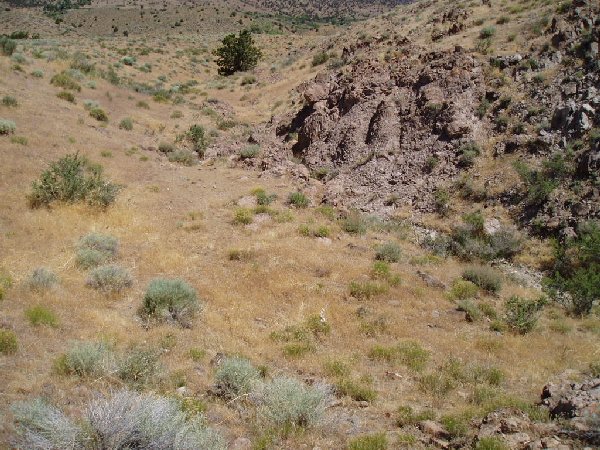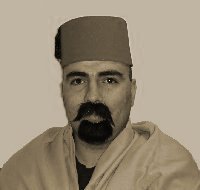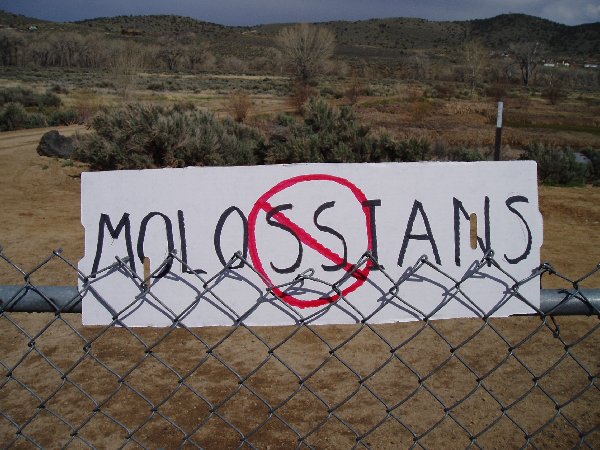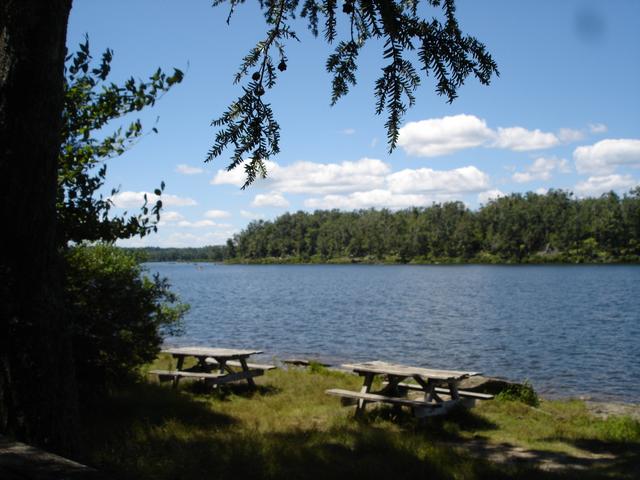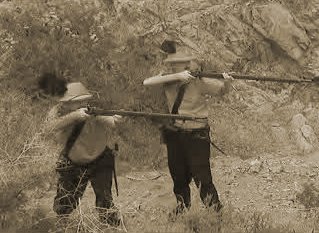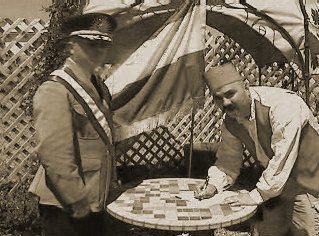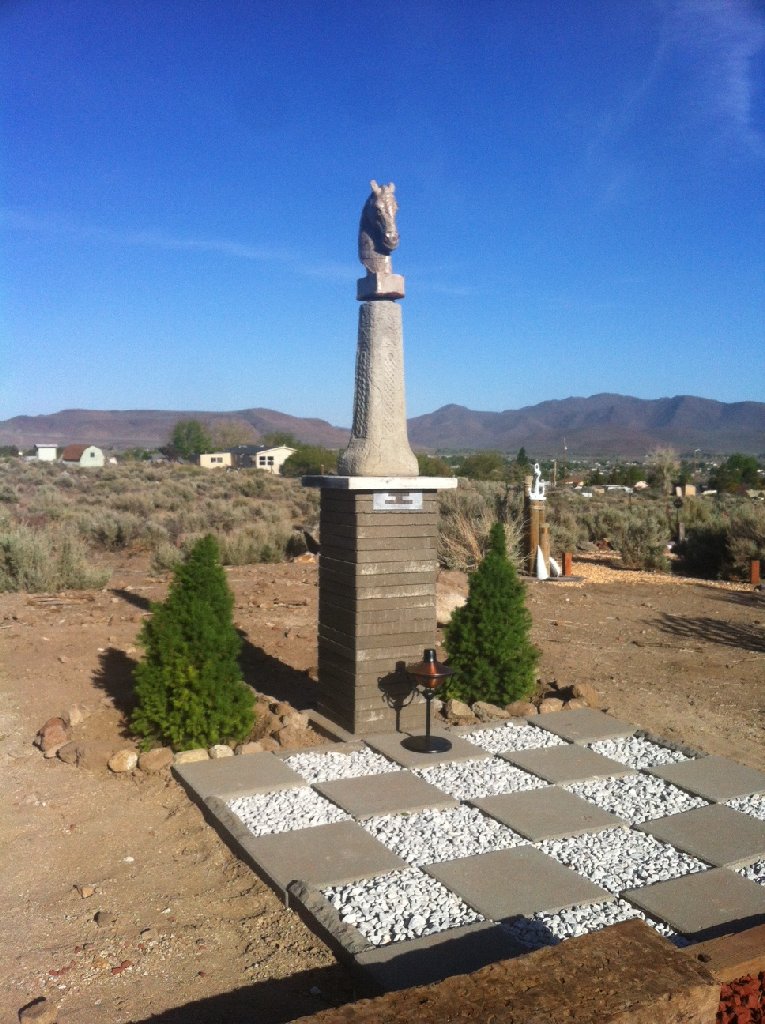Molossia-Mustachistan War
| The Molossia-Mustachistan War | |||||||
|---|---|---|---|---|---|---|---|
| |||||||
| Belligerents | |||||||
| Commanders | |||||||
| Strength | |||||||
| Land Forces: 4 soldiers Naval Forces: 2 vessels |
Land Forces: 2 soldiers Naval Forces: 2 vessels | ||||||
| Injuries and Casualties | |||||||
| 2 injured | 1 casualty | ||||||
The Molossia-Mustachistan War or The War with Mustachistan took place from 22 May - 8 June 2006, between the Republic of Molossia and Molossia's puppet state, the nation of Mustachistan. The roots of the conflict lay in conflicting territorial claims, a situation aggressively pursued by Mustachistan. Following the outbreak of armed conflict in late May 2006, the Mustachistanis were defeated in three separate battles and sued for peace.
Beginnings of the conflict
Mustachistan was the tongue-in-cheek creation of a friend of President Baugh of Molossia, who called himself Sultan Ali-Ali Achsenfree. Sultan Ali founded his own nation not only to participate in the world of small nations, but also as a bit of competition for Molossia. The principal rivalry centered around Mustachistan's claim to a large part of the U.S. State of Nevada, which included the territory of Molossia. In essence, at its founding, Mustachistan was little more than a puppet state of Molossia.
In March 2006, relations between Molossia and Mustachistan became increasingly strained. Though relations between the two had been amicable in the past, the Sultan being a personal friend of The President, Sultan Ali had increasingly pressed his claim that Molossia lies within Mustachistani territory, and was therefore a vassal state. President Baugh countered with the argument that: "Molossia has existed at its current location for eight years and is a well-established small nation with a defined territory." Adding insult was the fact that His Excellency assisted Sultan Ali in the establishment of his nation and the creation of his website. Mustachistan would not have existed at all without the technological aid of Molossia.
The Riverpark Incident
By April 2006, the territorial dispute between Molossia and Mustachistan had reached a new low point. Diplomatic talks had failed to resolve the friction between the two nations as Mustachistan persisted in its demand that Molossia surrender its sovereignty and become a vassal state.
President Baugh was a frequent visitor to a Riverpark near the Carson River, in Carson City, Nevada. This fact was well-known, and was used as a new source of conflict between the two nations. Sultan Ali attempted to bar The President from using the park, stating that it is in Mustachistani territory and was therefore closed to Molossian visits. He even went so far as to post a sign barring Molossians from the park. Of course this sign was immediately removed by Molossians, and act which only aggravated matters, dimming prospects for a positive resolution of the ongoing disagreement.
Brink of war
By early May 2006, following the Riverpark Incident, Mustachistan threatened to use force in resolving its dispute with Molossia over its territorial claims. Sultan Ali of Mustachistan stated unequivocally that Molossia's removal of the anti-Molossian sign from Riverpark and his repeated visits to the park were violations of sovereign Mustachistani territory and an overall affront to Mustachistani pride. President Baugh responded that the Mustachistani claim, which Molossia originally helped create, is meaningless, and that the park is in neutral United States territory and therefore open to all. In response to this, Mustachistan threatened to punish Molossia for its transgressions against Mustachistan.
There was genuine concern in the Molossian government that war might break out, so even as President Baugh continued to pursue a diplomatic solution to the crisis, he encouraged Molossians to be vigilant against foreign incursions. He further called on the Molossia's Naval Infantry to patrol the frontier and guard against any possible enemy action.
War is declared
Effective 22 May 2006, a state of war existed between Molossia and its puppet state, Mustachistan. Following the friction of the previous months and weeks, Mustachistan stated its intention to move its army into a position along Sutro Creek, only 1 kilometer away from the Molossian frontier. This action was deemed unacceptable by the Molossian government, and an affront to their national sovereignty.
In response, President Baugh mobilized the Naval Infantry, ordering them to deploy and intercept the Mustachistani Army in the field, to hopefully deal a decisive blow and bring a quick resolution to the conflict with minimal carnage.
President Baugh's speech declaring of war against Mustachistan was short, but effective:
I come before you today with a proclamation of the most serious import: Effective 22 May 2006, at midnight, Molossian Standard Time, our nation is at war with the nation of Mustachistan.
Today the nation of Mustachistan has opened hostilities with Molossia, and has begun moving its troops to within striking distance of our borders. This action will not stand, and I will not allow the threat of foreign military forces against our nation to go unchallenged. Therefore I have called upon our valiant Navy and Naval Infantry to stand ready to repel the Mustachistani's and remove their menace from our frontier. Even as we speak, the War Department has mobilizing our forces and they will soon deploy to meet with and destroy the Mustachistani threat. Our military is efficient, bold and courageous, and I am confident that it will prevail.
I call upon all Molossians to support our government and our military forces in this time of war. Molossia is a great nation, the greatest on earth. Our cause is just and our goals are worthy. We will triumph, and we will bring peace to this region again.
After war was declared, the Molossian War Office issued new rules to safeguard the Molossian population. Conservation at home was deemed to be very important and citizens were urged to walk instead of driving to conserve fuel, conserve to avoid waste (especially food), make time for war work, and buy Victory Bonds with their extra money. An extensive propaganda campaign was undertaken to remind citizens that their actions could help the war effort and our troops at the front.
The Battle of Lake Jean
- Main article: Battle of Lake Jean
The Molossian Naval Infantry was slowed by weather in late May in its advance against Mustachistani forces. However, as events unfolded slowly in the west, the nascent Eastern Front exploded into activity with a battle on Lake Jean, near the Protectorate of New Antrim. Lake Jean had been the target of Mustachistani forces seeking not only to gain a foothold in New Antrim, but also to divert resources from the developing campaign near the Molossian Home Territories.
Thus, the Molossian Naval Forces of New Antrim (The Atlantic Fleet) set out to repel the Mustachistani threat on Lake Jean. Mustachistani elements had moved to establish themselves on the lake, and Grand Admiral Hess immediately launched his fleet to repel the threat. The Atlantic Fleet consisted of two vessels, the Canoe-class MS-3 Boomer and the Kayak-class MS-4 Old Towne, both vessels in excellent fighting trim and manned by three very able sailors. The Boomer served as the fleet flagship. The Mustachistanis launched two vessels in response, two Kayak-class boats, the Dagger and the Corsica.
After a full day of naval skirmishes, Grand Admiral Hess repelled the Mustachistani forces and won the day for Molossia.
The Battle of Black Lizard Canyon
The Molossian Naval Infantry finally took to the field on 29 May 2006, and moved to intercept the Army of Mustachistan, which had deployed along Sutro Creek in an area called Black Lizard Canyon, 1 kilometer from the northern Molossian frontier. Marching through sagebrush and juniper trees and using the rocky terrain for cover, the Naval Infantry met with an ambush as Mustachistani forces attacked from a nearby ridge. The Molossian troops immediately deployed a skirmish line along the bottom of the creek. The Mustachistanis quickly followed up their initial gains by advancing their line forward to within 100 meters of the Molossian positions.
The two forces exchanged fire for a short period, before the Molossians bravely mounted a charge. Their surprise assault pushed back the Mustachistanis, and they shortly broke and ran, leaving Molossia in command of the canyon. The Molossian commander chose not to pursue the retreating Mustachistanis, and instead established defensive fighting positions on the battlefield. Through this exchange, a single Molossian was injured in the arm, while there was no word on Mustachistani casualties or injuries.
Following the battle, scouting patrols were sent out to determine the location of the Mustachistani Army.
The Battle of Rattlesnake Rift
Following the Mustachistani defeat at the Battle of Black Lizard Canyon, Mustachistani forces proved themselves to be elusive and difficult to engage in battle. Finally, on 3 June, Molossian scouts reported that the Mustachistani Army was in the vicinity of Mosquito Bend, along the Carson River. On 4 June, at 9:00am Molossian Standard Time, Molossian troops launched a daring amphibious assault on the Mustachistani forces at Mosquito Bend. This surprise attack from the water quickly sent the Mustachistanis scurrying for cover, with Molossian forces in hot pursuit.
At Rattlesnake Rift, a narrow defile near Heliotrope Falls, the Mustachistanis found themselves trapped, and chose to make a last stand. Repeated Molossian volleys failed to dislodge the well-entrenched Mustachistanis, so the decision was made to flank them by moving Molossian troops to the rocks above the canyon. This plan necessitated a treacherous climb up a steep cliff, but the Naval Infantry tackled this obstacle without pause. Once atop the cliff, they were able fire down on the Mustachistanis with complete impunity, causing havoc among the Mustachistani ranks. This proved to be the undoing of the Mustachistanis and they quickly surrendered. There were several wounded and one dead among the Mustachistani forces, while the Naval Infantry suffered no casualties.
The captured Mustachistanis were marched to Molossia and bivouacked under guard at the Alphonse Simms Memorial Broomball Field and Cosmodrome. It was presumed that this effectively ended the armed conflict phase of the war with Mustachistan, as their army had surrendered and forced to disband. Negotiations were opened to discuss the formal cessation of hostilities.
Peace and an end to the war
On 8 June 2006, a peace treaty was been signed between the Republic of Molossia and its puppet state, Mustachistan, agreeing to a complete cessation of hostilities and an end to the war between the two nations. In accordance with the treaty, Mustachistani troops held captive by Molossia were immediately repatriated to Mustachistan.
The key terms of the treaty required Mustachistan do the following:
- Relinquish all claims to Molossia.
- Respect Molossian rights to visit the Riverpark.
- Pay war reparations in the form of Cookie Dough, one tube a month for six months.
This treaty formally ended the war with Mustachistan in favor of Molossia. However, President Baugh extended the hand of friendship toward Mustachistan, in the hope that a positive future relationship can emerge between their two nations. Once friends, the two adversaries put their enmity behind them, to move forward into a peaceful future.
Aftermath of the war
Creation of the Mustachistan War Battlefields Park
The sacrifices made by both Molossians and Mustachistanis in the war between their two nations have been commemorated in the creation of the Mustachistan War National Battlefields Park. The park includes the area of the two battles fought, the Battle of Black Lizard Canyon and the Battle of Rattlesnake Rift. The new battlefield park provides the opportunity for visitors to explore the historic terrain where men fought and died for their countries in this mighty conflict.
Mustachistan War Memorial
On 18 June 2006, ten days after the conclusion of the War with Mustachistan, a War Memorial was dedicated in Molossia. Located near the new location of the Tower of the Winds, the monument was a simple column with a lion statue at the top. The lion represented victory and strength, while its stance (statant as opposed to rampant) was meant to suggest thoughtfulness as opposed to aggressiveness. The column itself was made up of twenty layers, one for each day of the war, plus one for each of the two major battles fought by Molossian troops.
In 2014 President Baugh replaced the Mustachistan War Monument with the Molossian Heroes Monument. This new monument is dedicated to all heroes of Molossia, including those that served during the Mustachistan War.
